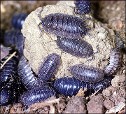| |
The Finest
Pest Control Company in NorthEast, Ohio
Pest Control • Animal Trapping • Chimney Caps/
Exclusions • Termite
Treatments
Pest Identification:Occasional
invaders, light attracted pest, miscellaneous pest |
 |
|
|
(Chilopoda) |
Characteristics: - 1/8 - 6 inches long
- Yellowish to dark brown in color with dark markings
- House centipedes are greyish yellow, 3 stripes down the
back, very long legs, banded with white
- antannae
- Flattened body with a pair of legs on each of their 15 -
177 segments
- First segment of legs have poison glands that kill insects and
spiders
- Can bite humans, bite is equivalent to a bee sting
History: - In the summer lay around 35 eggs in or on the soil
- They increase segments with each molt until becoming an adult
- As an adult they live an average of 5-6 years
- They overwinter outdoors
- Live in moist environments
- Nocturnal
|
|
|
 |
|
|
(Diplopoda) |
Characteristics: - 5/8 - 4 inches in length
- Brown or black; some may be orange or red
- Long, cylindrical, 2 pairs of legs on each of the many
segments
History: - Invade structures when habitat is flooded or dry periods /
mating
- 20 - 300 eggs laid in nests in the soil
- They molt 7 - 10 x increasing the amount of segments each time
- Life span is around 2 years
- Adults and young can overwinter
- Feed on decaying organic matter
- Prefer outdoors where moisture and food sources are abundant
- Nocturnal
- Produce a foul smelling fluid exiting sides of body that is
toxic to some insects and small animals
- The liquid substance can cause blisters on human skin
|
|
|
 |
Grasshoppers and Crickets |
|
(Orthoptera) |
Characteristics: - 3/4 inches long
- Dark brown - gray or blackish
- nocturnal
- omnivorous
History: - Related to cockroaches
- Have gradual metamorphisis
- Can cause damage to fabrics such as
- rayon, linen, and furs
- paper, all food,
- rubber
|
|
|
 |
|
|
(Insecta) |
Characteristics: - 1/4 - 1 inch long
- Dark brown - black in color
- Body is long / flat/ with pincer like apendages at end of
abdomen
- Has fully developed hind wings folded beneath leathery
front wings
History: - Feeds on plant matter
- Lay 50 eggs in a batch under stones or boards
- Gradual metamorphosis (egg, nymph, and adult)
- Molt between 4 - 5 times
- Live outdoors under rocks, stones, etc.
- Nocturnal
- Invades structures in the fall at night
- They produce foul odors when crushed
|
|
|
 |
|
|
(Coccinellidae) |
History: - Very beneficial
- Predators of plant eating pests that attack trees, shrubs,
flowers, and vegatables
- Asian lady beetles can cause considerable trouble by invading
buildings
|
|
|
 |
|
|
(Bryobia praetiosa) |
Characteristics: - Smaller than a pin head
- Bright red
- Front legs are as long as the body and longer than the other
6 legs
History: - Often occur in large numbers
- Stain when crushed
- Migrate into homes when there is an overpopulation and also
during drought or cold weather
- Adult mites lay eggs in crack and crevices
- Foundations, walls, and around trees
- Overwinter in exterior walls
- Inactive during cold weather and very hot weather
- Come out in brief periods of warm weather in winter
and spring
- Heavy infestations can also occur in summer and fall
|
|
|
 |
|
|
(Crustacea) |
Characteristics: - 1/4- inch - 5/8 inch long
- Dark gray
- They have a hard shell with segments, 2 antannea, 7 pairs of
legs
History: - Nuisance pest
- Live in areas with higher moisture than normal
- Feed on organic matter
- Active at night
- Females carry eggs on their body in a pouch
- Around 24 - 28 eggs fit inside the pouch
- The young hatch in about 45 days
- Molt every 1 to 2 weeks
- Adults live an average of 2 years
|
|
|
 |
|
|
(Arachnida) |
Characteristics: - Eight legs
- Their bodies have two regions
- Cephalothorax: Includes (Fused head and thorax)
- Abdomen
- They have jawlike structures, which has 2 hollow clawlike
fangs
- Venom is injected from these fangs
- Spin webs
- Like moisture
History: - Spiders are very benificial, because they kill other insects
- Some spiders though can cause pain and even
kill humans and animals
- If bitten, victim should bring speciman with them to physician
|
|
|
|
|
|







